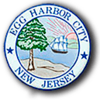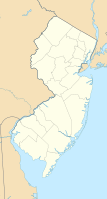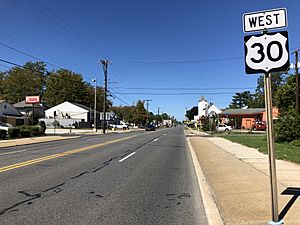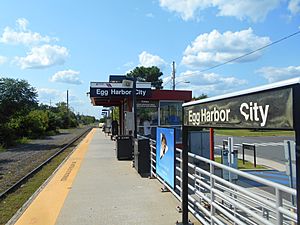Egg Harbor City, New Jersey facts for kids
Quick facts for kids
Egg Harbor City, New Jersey
|
||
|---|---|---|
|
City
|
||
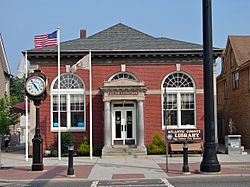
Former Egg Harbor Commercial Bank building, now the local branch of the Atlantic County library system
|
||
|
||
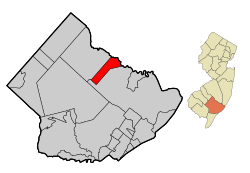
Location of Egg Harbor City in Atlantic County highlighted in red (left). Inset map: Location of Atlantic County in New Jersey highlighted in orange (right).
|
||

Census Bureau map of Egg Harbor City, New Jersey
|
||
| Country | ||
| State | ||
| County | Atlantic | |
| Incorporated | June 14, 1858 | |
| Named for | Gull eggs | |
| Government | ||
| • Type | Faulkner Act (small municipality) | |
| • Body | City Council | |
| Area | ||
| • Total | 11.42 sq mi (29.58 km2) | |
| • Land | 10.85 sq mi (28.10 km2) | |
| • Water | 0.57 sq mi (1.48 km2) 4.99% | |
| Area rank | 198th of 565 in state 10th of 23 in county |
|
| Elevation | 13 ft (4 m) | |
| Population
(2020)
|
||
| • Total | 4,396 | |
| • Estimate
(2023)
|
4,385 | |
| • Rank | 400th of 565 in state 17th of 23 in county |
|
| • Density | 405.1/sq mi (156.4/km2) | |
| • Density rank | 459th of 565 in state 14th of 23 in county |
|
| Time zone | UTC−05:00 (Eastern (EST)) | |
| • Summer (DST) | UTC−04:00 (Eastern (EDT)) | |
| ZIP Code |
08215
|
|
| Area code(s) | 609 exchanges: 704, 726, 804, 965 | |
| FIPS code | 3400120350 | |
| GNIS feature ID | 0876119 | |
Egg Harbor City is a city in Atlantic County, in the U.S. state of New Jersey. The city, and all of Atlantic County, is part of the Atlantic City-Hammonton metropolitan statistical area, which in turn is included in the Philadelphia-Reading-Camden combined statistical area and the Delaware Valley. As of the 2020 United States census, the city's population was 4,396, an increase of 153 (+3.6%) from the 2010 census count of 4,243, which in turn reflected a decline of 302 (−6.6%) from the 4,545 counted in the 2000 census.
The city had the seventh-highest property tax rate in New Jersey, with an equalized rate of 5.044% in 2020, compared to 2.560% in the county as a whole and a statewide average of 2.279%.
Contents
History
The area home to Egg Harbor City was settled by Europeans in 1614, when the Dutch vessel Fortuyn landed at the Mullica River. The first settlers named the area "Eyren Haven" after the large number of gull eggs in the area.
In 1854, the Camden and Atlantic Railroad opened. On December 14, 1854, a group of prominent German Americans from Philadelphia, including William and Henry Schmoele and Philip Mathias Wolsieffer, incorporated the "Gloucester Farm and Town Association", which purchased approximately 38,000 acres of woodland north of the railroad to serve as a refuge for those being persecuted in the anti-immigrant violence known as the Know-Nothing movement. The corporation planned two cities: a four-square-mile city called "Pomona" closest to the railroad, and another city called "Gloucester" to the north. However, the twin city scheme was dropped in favor of one seven-mile-long metropolis called "Egg Harbor City". The development's layout contained an urban "city core" containing 100x150-foot lots bounded by New York Avenue to the west and Baltimore Avenue to the east, while the remainder of the land was divided into separate 20-acre farm parcels. The corporation issued stocks at $300 per share; with each share, stockholders would acquire one residential building lot and one farm parcel. The city was marketed heavily in cities containing large German American populations, including Baltimore, Buffalo, Cleveland, Milwaukee, and St. Louis.
The land was divided and plotted from the railroad north to the Mullica River, west ending at Hanover Avenue, and the easternmost land being the home of the present-day Stockton University. The north-south streets were named for cities with large German populations, while the east-west streets were named for notable Germans, starting with Agassiz Avenue (current-day White Horse Pike) to the south, and Zschokke Avenue to the north. The city was planned to include ample public green space; both New York Avenue and Baltimore Avenue were platted with wide medians to accommodate garden plats, Landing Creek would have been dammed to create an artificial lake called "Gloucester Lake", and Egg Harbor City Lake would have been made into a reservoir at the center of a large urban park containing landscaped gardens, an arboretum, and a model farm. The Mullica River was proposed to be made navigable for commercial vessels, and the northern edge of the street grid along the river was to contain canals and wharfs for ships to dock.
Egg Harbor City was officially incorporated as a city by an Act of the New Jersey Legislature on June 14, 1858, from portions of Galloway Township and Mullica Township. The city was reincorporated on February 13, 1868. The city's growth was slowed due to an economic crisis in 1857, and then further during the Civil War. Though the city did not grow to the size as originally proposed, it grew in population steadily in the 1870s, and remained a virtual island of German language and culture in South Jersey for more than 50 years.
Geography
According to the United States Census Bureau, the city had a total area of 11.42 square miles (29.58 km2), including 10.85 square miles (28.10 km2) of land and 0.57 square miles (1.48 km2) of water (4.99%).
Unincorporated communities, localities and place names located partially or completely within the township include Clarks Landing, Gloucester Furnace and Gloucester Lake.
The city borders the municipalities of Galloway Township and Mullica Township in Atlantic County; and Washington Township in Burlington County.
The city is one of 56 South Jersey municipalities that are included within the New Jersey Pinelands National Reserve, a protected natural area of unique ecology covering 1,100,000 acres (450,000 ha), that has been classified as a United States Biosphere Reserve and established by Congress in 1978 as the nation's first National Reserve. All of the city is included in the state-designated Pinelands Area, which includes portions of Atlantic County, along with areas in Burlington, Camden, Cape May, Cumberland, Gloucester and Ocean counties.
Demographics
| Historical population | |||
|---|---|---|---|
| Census | Pop. | %± | |
| 1860 | 789 | — | |
| 1870 | 1,311 | 66.2% | |
| 1880 | 1,232 | −6.0% | |
| 1890 | 1,439 | 16.8% | |
| 1900 | 1,808 | 25.6% | |
| 1910 | 2,181 | 20.6% | |
| 1920 | 2,622 | 20.2% | |
| 1930 | 3,478 | 32.6% | |
| 1940 | 3,589 | 3.2% | |
| 1950 | 3,838 | 6.9% | |
| 1960 | 4,416 | 15.1% | |
| 1970 | 4,304 | −2.5% | |
| 1980 | 4,618 | 7.3% | |
| 1990 | 4,583 | −0.8% | |
| 2000 | 4,545 | −0.8% | |
| 2010 | 4,243 | −6.6% | |
| 2020 | 4,396 | 3.6% | |
| 2023 (est.) | 4,385 | 3.3% | |
| Population sources: 1860–2000 1860–1920 1860–1870 1870 1880–1890 1890–1910 1910–1930 1940–2000 2000 2010 2020 |
|||
2010 census
The 2010 United States census counted 4,243 people, 1,593 households, and 1,075 families in the city. The population density was 388.1 per square mile (149.8/km2). There were 1,736 housing units at an average density of 158.8 per square mile (61.3/km2). The racial makeup was 62.95% (2,671) White, 17.94% (761) Black or African American, 0.38% (16) Native American, 2.22% (94) Asian, 0.09% (4) Pacific Islander, 12.28% (521) from other races, and 4.15% (176) from two or more races. Hispanic or Latino of any race were 26.28% (1,115) of the population.
Of the 1,593 households, 30.2% had children under the age of 18; 39.0% were married couples living together; 21.3% had a female householder with no husband present and 32.5% were non-families. Of all households, 25.3% were made up of individuals and 8.5% had someone living alone who was 65 years of age or older. The average household size was 2.64 and the average family size was 3.13.
24.9% of the population were under the age of 18, 10.5% from 18 to 24, 25.9% from 25 to 44, 26.9% from 45 to 64, and 11.8% who were 65 years of age or older. The median age was 36.4 years. For every 100 females, the population had 96.9 males. For every 100 females ages 18 and older there were 93.9 males.
The Census Bureau's 2006–2010 American Community Survey showed that (in 2010 inflation-adjusted dollars) median household income was $52,893 (with a margin of error of +/− $8,582) and the median family income was $67,654 (+/− $6,555). Males had a median income of $35,182 (+/− $7,553) versus $33,994 (+/− $2,214) for females. The per capita income for the borough was $22,294 (+/− $3,702). About 11.3% of families and 20.9% of the population were below the poverty line, including 36.2% of those under age 18 and 12.7% of those age 65 or over.
Education
The Egg Harbor City School District is responsible for the education of public school children in pre-kindergarten through eighth grade. As of the 2021–22 school year, the district, comprised of two schools, had an enrollment of 529 students and 55.0 classroom teachers (on an FTE basis), for a student–teacher ratio of 9.6:1. Schools in the district (with 2021–22 enrollment data from the National Center for Education Statistics) are Charles L. Spragg School with 244 students in PreK to Grade 3 and Egg Harbor City Community School with 276 students in grades 4 to 8.
Students in ninth through twelfth grades attend Cedar Creek High School, which is located in the northern section of Egg Harbor City and opened to students in September 2010. As of the 2021–22 school year, the high school had an enrollment of 962 students and 77.8 classroom teachers (on an FTE basis), for a student–teacher ratio of 12.4:1. The school is one of three high schools operated as part of the Greater Egg Harbor Regional High School District, which also includes the constituent municipalities of Egg Harbor City, Galloway Township, Hamilton Township and Mullica Township, and participates in sending/receiving relationships with Port Republic and Washington Township (Burlington County). Cedar Creek High School is zoned to serve students from Egg Harbor City, Mullica Township, Port Republic and Washington Township, while students in portions of Galloway and Hamilton townships have the opportunity to attend Cedar Creek through the school of choice program or through attendance in magnet programs offered at Cedar Creek. Seats on the nine-member board are allocated based on the population of the constituent municipalities, with one seat assigned to Egg Harbor City.
Township public school students are also eligible to attend the Atlantic County Institute of Technology in the Mays Landing section of Hamilton Township or the Charter-Tech High School for the Performing Arts, located in Somers Point.
The Pilgrim Academy is a private Christian school. Founded by Warren Allem in 1971, the school teaches children from kindergarten through 12th grade. The name is taken from John Bunyan's allegorical novel The Pilgrim's Progress.
The Roman Catholic Diocese of Camden formerly maintained the St. Nicholas School in Egg Harbor. It closed in 2007 with a private elementary school opening in its place.
Transportation
Roads and highways
As of May 2010[update], the city had a total of 50.09 miles (80.61 km) of roadways, of which 34.05 miles (54.80 km) were maintained by the municipality, 14.46 miles (23.27 km) by Atlantic County and 1.58 miles (2.54 km) by the New Jersey Department of Transportation.
U.S. Route 30 (the White Horse Pike) is the most significant highway passing through Egg Harbor City. Egg Harbor City also features the northern terminus of New Jersey Route 50, which ends at an intersection with US 30 near the center of the city. Major county routes passing through the city include County Route 561 and County Route 563.
The closest limited access road is the Atlantic City Expressway which is two towns away in Hamilton Township while the Garden State Parkway is accessible in neighboring Galloway Township.
Public transportation
The Egg Harbor City station provides NJ Transit service on the Atlantic City Line, connecting 30th Street Station in Philadelphia and the Atlantic City Rail Terminal in Atlantic City.
NJ Transit provides bus service to and from Atlantic City on the 554 route.
The South Jersey Transportation Authority provides shuttle bus service connecting the Egg Harbor City train station with Atlantic City International Airport and Stockton University, as well as other area locations.
Wineries
Notable people
People who were born in, residents of, or otherwise closely associated with Egg Harbor City include:
- Lou Bauer (1898–1979), baseball player who played a single major league game, for the Philadelphia Athletics, as a 19-year-old
- Kathleen Crowley (1929–2017), actress
- John D'Agostino (born 1982), professional poker player
- Louis Kuehnle (1857–1934), entrepreneur and politician who was a pioneer in the early development of Atlantic City
- Frank Morgenweck (1875–1941), basketball player, coach and administrator, member of the Basketball Hall of Fame
- Peace Pilgrim (1908–1981, born Mildred Lisette Norman), peace activist honored in Egg Harbor City by Peace Pilgrim Park and by a birthday celebration each year in July
- Lindsey Petrosh (born 1989), Miss New Jersey 2012
- Tim Reilly, head coach of the Lafayette Leopards baseball team
- Captain Charles Saalmann (1838–1909), infantry captain in the Civil War, Acting Commissary of Subsistence in General William T. Sherman's March to the Sea, vintner
See also
 In Spanish: Egg Harbor City para niños
In Spanish: Egg Harbor City para niños


